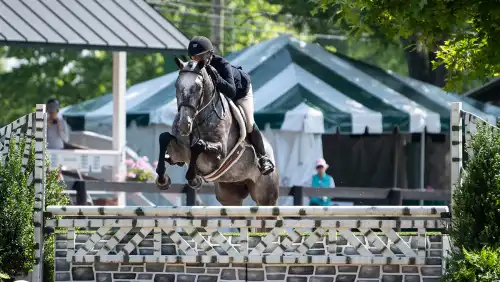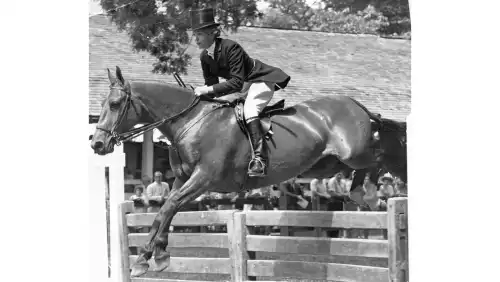Top hunter rider Louise Serio reflects on which hunter programs are working and shares ideas about how to evolve the sport.
The top two riders at this year’s USHJA International Hunter Derby Championship in Lexington, Kentucky—Tori Colvin and Geoffrey Hesslink—are both young professionals, which gives me so much hope for the future of the sport. We need to have the young adults out there aspiring to become top hunter riders. It’s not easy getting established with good clients and good horses, and we have a new generation of riders in the process of doing it, and they’re doing it well. We saw young riders with good results against the veterans across the country all year, including at championship shows.
There are great goals depending on your level, like qualifying for Devon (Pennsylvania) or indoors, competing in USHJA National and International Hunter Derbies or the Green Hunter Incentive Championship, and showing in the World Championship Hunter Rider program. Depending on where you live in our huge country, you might have different goals. For example, in Texas they have the Texas Super Series Green Hunter Stakes, which is a great program. And this year we have new regional championships for the USHJA Green Hunter Incentive Championships. Hopefully that will help invigorate those divisions a little bit. Even if traveling to Kentucky or indoors is out of the question, there are plenty of meaningful objectives.

This year, young professionals have turned in some great results, including Tori Colvin riding Cuba to the top of the USHJA International Hunter Derby Championship. Photo by Kimberly Loushin
Young trainers and riders starting their business these days will have plenty of challenges. They must be good at business, people skills and horsemanship.
Personally I think that young trainers and riders should apprentice and train under someone with lots of experience, then decide how they want to be involved with the sport. A lot of trainers who have been doing this a long time have made mistakes, and we can share that knowledge. Sometimes it makes sense when starting out to start at a lower level, run a nice barn that goes to smaller shows so you can make your mistakes while building your business, and decide what works for you.
From a business perspective I can understand why there’s so much more emphasis on competing versus learning to ride these days. Indeed, horse showing is one way for trainers to make a living. At shows you’re getting exposure, and that’s where most of the buying and selling happens.
If you are a small business owner who follows the laws, the costs are huge. Even if you aren’t going to a horse show, costs of hay, bedding, labor, insurance, taxes and workers’ compensation are enormous. Still, I’ve met a lot of people who are choosing to travel less and stay home more, despite the financial interest in being on the road. Many people would rather compete less and closer to home and have a more normal life and spend time with their families.
So this summer we showed a little less—I like to spend time with my granddaughter—and tried something new: running two young horse camps at my farm. The horses came on Wednesday and got settled in for the four-day young horse camps. We free jumped the horses, then two of my riders who specialize in young horses rode them throughout the weekend, starting by flatting in each of the rings to get acclimated to the facility. We practiced gymnastics and courses and worked with each horse individually to decide what they needed. It was really well received, and I was pleased to do something so positive for all involved.
A Mess With Medications
ADVERTISEMENT
One of our top hunter competitors was out of the show ring this year as Kelley Farmer and her Lane Change Farm partner Larry Glefke were set down for drug violations, though the U.S. Equestrian Federation just vacated their decision, and Kelley and Larry are back in the show ring. That was a very big deal.
I’m concerned about the whole mess and the fact that the lab made so many mistakes. We rely on the USEF to run a meticulous testing program that will get accurate results, to run fair hearings and to give due process to those who come before the USEF Hearing Committee. The federation has lost the faith of many of its members.
After a major mistake like this I’m counting on the board of directors and Executive Committee to make sure this never happens again and make sure that they will give us a level playing field. I do not think the USEF should be in the lab business. I’m looking forward to hearing their reaction to this and who will be held accountable.
I think we all need to take a fresh look at the medications our horses are getting.
Looking Ahead
I’m really proud of the hunters and where they have come in the last five years. I think things are looking up, and now we have to look at the future and figure out what’s next.
The USHJA Green Hunter Incentive Program continues to evolve, and this year we’ll be adding 3’6″ and 3’9″ divisions at the national championship as well. That program has been a home run since the beginning, and its self-funding model, which Colleen McQuay introduced, has been working so well. It has sparked new interest in young horses, which was one of the goals from the beginning.
I get bored with four jumping classes and an under saddle, which is a big part of the reason the USHJA International Hunter Derby and USHJA National Hunter Derby events are so popular. This year will be really exciting with the derbies implementing the star system, which will create three tiers of difficulty. This means that if you have a younger horse, or one who’s ready to go in his first derby, you’ll know which classes are appropriate.
We’ll also have new USHJA Derby Hunt And Go classes, sort of a power and speed class for hunters, which will be really exciting. And the USHJA National Hunter Derbies continue to be a great steppingstone into that program.
ADVERTISEMENT
I’d also like to see more classics to keep things interesting. Maybe we could switch it up and rather than having four jumping classes and a hack in a division, we could have a three-round classic with movement judged on course.
Continuing Into The Future
Katie Prudent’s comments about the state of show jumping midway through this year started lots of conversations throughout the hunter/jumper world, and top equestrians have been especially vocal with their opinions. Everyone is asking the same question: How we can preserve great horsemanship and continue to move the sport forward?
George Morris, for example, recently wrote an article in the Chronicle critical of modern hunter riders’ form over fences. It’s not a new sentiment, but it got me thinking. On one hand, I don’t think all hunter riders have lousy form. There are plenty of people who have kept very nice style after being brought up through classical American teaching methods, and there have always been some riders who just have their own style.
And the best horsemen and riders aren’t all stylists. Take Rodney Jenkins, who’s won more in the history of our sport than anyone else. Rodney had his own style, and his horses jumped beautifully. He was very fluid in the air. I think a certain amount of fluidity and looseness in the air helps the horse jump well. I also think the rider’s back has to follow the bascule of the horse to promote proper jumping style. If there is a lack of classical riding being taught, we can see it in hunters and jumpers at the lower heights.
At the same time, George isn’t wrong, of course. These days there is so much emphasis on showing and less on teaching riding. Surely that contributes to what we’re seeing in the ring, too.
So maybe it’s time to institute a style award, as they sometimes have in the jumpers. That would certainly encourage classical riding, and it would be especially supportive to less established riders, who might not have the top horse in the class but who could be rewarded for outstanding position.
I also believe there could be a place for a special elite hunter competition held under Fédération Equestre Internationale rules. I’ve talked to other top pros, and many of them agree that they have horses in the barn that could be great candidates for that. How fantastic would it be to have American hunters competing at the most prestigious international events in our country, like the Longines Miami Global Champions Tour? Let’s continue to brainstorm creative ways to keep the sport exciting, while still holding on to our roots.
The 2001 Chronicle of the Horse’s Show Hunter Horseman of the Year, Louise Serio, has trained numerous horses to tricolors at the biggest shows in the country, including Gray Slipper, Red Panda, Irresistible, Castle Rock, Rock Harbor, Harbor Bay and El Primero. Serio, Kennett Square, Pennsylvania, co-founded the American Hunter Jumper Foundation and World Champion Hunter Rider program, and she currently heads the USHJA National Hunter Derby Committee. A National Show Hunter Hall Of Fame Inductee, Serio has won the USEF Emerson Burr trophy and earned the leading lady rider at Devon (Pennsylvania) four times.















